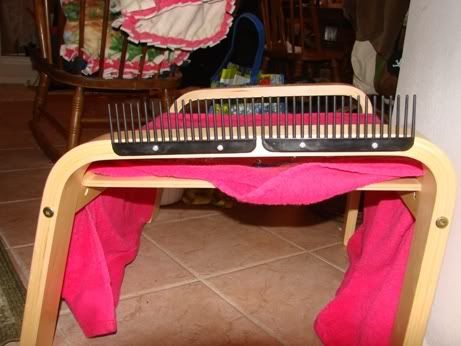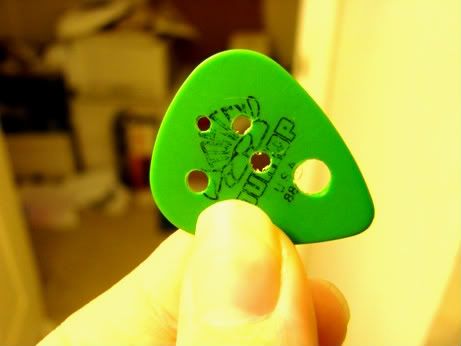I haven't updated in ages, and the reason is terribly silly. I've done SO much recently that I've dreaded how long it would take me to post it all. I'll keep everything fairly brief so that I can get through it all. Basically this is what I've been doing.
I ordered a fleece!
I ordered a pound of Cheviot wool online. I got it raw because I wanted to experience cleaning and carding the wool for myself. Boy, was THAT a bad idea. If you're buying your first raw fleece to prepare on your own, and you have NO idea what to expect, make sure that it has been skirted. Skirting is when someone goes through the fleece and picks out all the hay, grass, burrs, and all that good stuff that gets stuck in there when a sheep is outside. It's also when they take out the bits of wool that are caked with sheep poo. Yeuch! DO NOT buy a fleece for the first time if it has not been skirted. Or, if you must, make sure that it's a covered sheep (some shepherds put canvas coats on their sheep to keep them clean), or that it doesn't have much VM in it. (VM is vegetable matter. It's the stuff I was talking about before.) If you've never ever ever done any preparation before and you just buy some wool without researching it, you WILL be sorry. I was tearing my hair out! There's nothing more frustrating than washing a fleece for five hours, drying it, then realizing that there is no shortcut for getting all that junk out. You have to get it out by hand. All in all, I think my fleece had more grass and hay than wool. This wasn't miscommunication on the seller's part - she even told me that it had about as much VM as she would tolerate in a fleece. I just had no idea what 'vm' meant and thought that she meant it was coarse.
So, I put it in my sweater bag and soaked it in hot water in the kitchen sink. The very first time I soaked it, I didn't even add any soap. It was in there maybe ten minutes max, and when I pulled the bag out and switched it to the other side of the sink, the water it had been sitting in looked like coffee. Gross! It took me five hours to soak it in soapy water, rinse it several times, soak it in more soapy water, and rinse it again several times. Then I tossed it in the washer and turned on the spin cycle to dry it out a bit. I let it sit out for a few days to dry, every now and then I tossed it back in the washer to spin a while, and then I grabbed a handful and tried to card it up. The result was an hour and a half of carding to produce one rolag, because I was a noob at carding AND I had to stop every few moments to pick more junk out of the wool. I'd hopedi t would just fall out while I carded. No such luck.

After the first washWell, by that point I was frustrated. I went online googled for some kind of shortcut to get all that extra stuff out of my wool. I found a site (I can't remember where) that said that fluffing it up would help, pulling the fibers apart width-wise so that it was just one fluffy cloud of fiber with no dense spots, and that a lot of the junk would fall out. It would take a while, but it wasn't so bad if you did it while watching a movie or something. Well, I tried it. I really did. And fluffing helped a little, but I was still picking the majority of the stuff out. It really didn't shorten the process at all, and I wouldn't be able to do it while watching a movie because I'd be concentrating on the wool the whole time.
Finally, clueless and needing direct advice from someone who knew what they were doing, I went on Ravlery and asked in the fiber prep group. Lo and behold, I got an almost immediate answer - The vm wasn't falling out because the wool wasn't completely cleaned. There was still some lanolin (grease) and it was grabbing onto the vegetable matter. That's right. After five hours of backbreaking work at the kitchen sink, soaking and rinsing and soaking again and again.... My wool wasn't clean. In retrospect, I know why. One of the reasons was that I let my wool soak for five or ten minutes, max, before I moved it to the other side of the sink. If you've never cleaned wool before, take heed. When you let your wool soak, especially with the detergent water, LET IT SOAK. Leave it there for fifteen or twenty minutes. Don't take it out while the water is still hot to the touch. Wait until it begins to turn to a comfortably warm temperature to take it out of the water. But don't let the water cool TOO much, either. That will let the lanolin (the grease) settle back onto the wool, and you don't want that. There was another factor in why my wool wasn't clean, and you'll see why in the next paragraph.
So, I went to my bag and pulled ALL of the wool out of it. I unrolled it from the balls it had formed in when it had shipped. This is the first time I did this. When I washed it, I had just dumped the bags of wool from the shipping into my sweater bag. I'd complained online a few times that whoever cut the fleece hadn't kept it in lock formation and had just let it kind of tangle. When I unrolled the wool, I knew it was time to eat a big helping of humble crow pie. There, inside, like a cocoon, were lovely locks. I'd been looking at it from the wrong side, and I'd never bothered to spread it out. Not only that, but the lovely locks were DIRTY. Not just full of VM, which they were, but DIRTY. The outside was nice and fluffy and white, but inside it looked as though the hours of soaking had never even happened.
So, I put the spread-out wool back in the sweater bag and took it to the sink. Five more hours of soaking, another day of drying. It was in this second wash that I found out something that would have been nice to know earlier: The drain plugs for my kitchen sink are leaky. At one point, I let the wool sit in the water while I went to the bathroom, checked some things online, and played some solitaire. When I came back in about 15 minutes, the sinkful of water was completely gone. I thought that the wool was RIDICULOUSLY absorbant. Not so. It had all seeped out. What a pain! So all my soaks had to be fairly brief. In fact, it took longer to fill the sink between soaks than it took to actually soak. By the time it had dried, I pulled it out, sat down at the table with a towel across my lap, the wool on the floor to my left, a bowl on the floor to my right, and another bowl on the table in front of me. And I began to fluff again. I went through and fluffed and fluffed and put all the nice clean pieces in the bowl on the table. The hopelessly tangled bits and the pieces that were almost 80% grass went into the bowl on the floor. I soon found out something even more depressing than the vegetable matter matter. I had felted a goodly sized portion of my first fleece. There was no way of saving most of it.I took what little I had salvaged, sat down on my bed, and began to sort through it. I found something even more upsetting.

All that remainsImagine mowing your lawn. First, imagine that the grass is very tall. Usually, to avoid stalling the blade, you raise your mower up a few inches and mow the grass, then lower it down again and go over it a second time so that it gets cut the way you want to. Obviously, the grass clippings that you have to rake up afterward are probably shorter than if you had just mowed the whole lawn with the mower close to the ground in one pass. It's the same with shearing sheep. Sometimes the person who shears the sheep will make a second pass over one spot, and when that happens, there's something caled second cuts. These are shorter than the staple length, because they've been cut twice. Most people either throw them out or put them aside for art yarns, felting, and so on.
In my case, I think I got third and fourth cuts. Either that or I managed to break the fibers a lot. Most of the fibers that I sorted through wound up being an inch or less. Cheviot wool usually has a staple of about 4 to 5 inches, and I definitely had a lot of bits that were that long, some even longer. But the majority was almost as short as cotton.
So, I took the little that I could use for spinning, put it in the sweater bag, and washed it again. THIS time, I actually paid attention to the 'don't swish, don't agitate, don't even breathe on it!' rule. And, in washing this smaller amount, I discovered another mistake I'd made when I washed the whole fleece. I laid the smaller bag of wool on top of the water very very gently and poked it with one finger to submerge it, and then I stepped back and didn't touch it again. The whole bag of fleece sank into the water, totally sank to the bottom. Before, the main reason I had messed with the wool so much (and probably led to it felting) was because it wouldn't submerge. I had to push down with both hands to get it to go under the water, and then I held it against the bottom of the sink and pushed to make all the air bubbles come to the surface. Later on, I found the reason behind this. I don't remember where it was, but I read online somewhere that the amount of water, not the amount of soap, determines how well your wool washes. With the pound of wool that I'd gotten, I shouldn't have been cleaning it in my kitchen sink. I should have been upstairs soaking it in my bathtub. The sink was crowded and full with my wool in it. That probably led to its felting AND contributed to its continued filthiness.
So now, after all this is said and done, I have a measley amount of fuzzy, soft, white wool to show for it. I'm proud of it, though. It's cuddly and soft and while it's probably not even a full ounce, it's the fruit of my labor. My cat is happy, too. Since the rest of the wool was basically useless, I left it in the sweater bag and let it sit out on the floor. She's been seen cuddled up next to it these past few days. I've been calling it her pet sheep. Yesterday, I was eating breakfast, and when I looked over, I saw her laying next to the bag, lifting one paw to pat it. She's happy, so I guess I am, too. I tossed the bag in the washer with some detergent, put it through a full cycle so that it would solidify a bit more into balls, and now it's in the dryer. As soon as I finish writing this tale, I'm going to go get it from the dryer and make a certain feline very happy.
Coming soon: fiber prepping tools, blending, and my first REALLY successful dye project!
Plus: I finally finished that yarn I've been talking about! Pics SOON!
 Above is an example of a hackle. It's essentially a 2x4 with nails evenly spaced, clamped to a tabletop. Well, I suck at nailing evenly or precisely, so I did this the easy way.
Above is an example of a hackle. It's essentially a 2x4 with nails evenly spaced, clamped to a tabletop. Well, I suck at nailing evenly or precisely, so I did this the easy way. Combs, screwed into the side of a breakfast tray! Unfortunately, only after I finished this did I discover that the breakfast tray wobbles diagonally. But it's fine for now!
Combs, screwed into the side of a breakfast tray! Unfortunately, only after I finished this did I discover that the breakfast tray wobbles diagonally. But it's fine for now!














